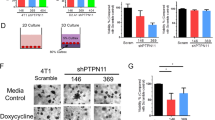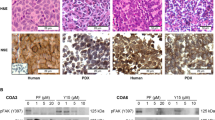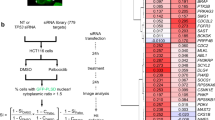Abstract
Activation of focal adhesion kinase (FAK), overexpressed in several human cancers, induces survival, proliferation and motility of cells in culture, but its functional importance in human tumor growth in vivo has not been elucidated. I explored the role of FAK in regulating tumorigenicity of human carcinoma cells, HEp3. These cells overexpress urokinase receptor (uPAR) which, by activating α5β1 integrin, initiates an intracellular signal through FAK and Src leading to ERK activation and tumorigenicity in vivo. Down regulation of uPAR in these cells led to a ∼3–5-fold reduction in FAK phosphorylation and association with Src and dormancy in vivo. Both FAK phosphorylation and ability to grow in vivo were restored by re-expression of uPAR. The FAK signaling pathway in T-HEp3 cells, measured by FAK phosphorylation, GTP-loaded Ras and ERK activation, was inhibited by transient or stable transfection of FAK related non-kinase (FRNK), known to have a dominant negative function, but not by a FRNK mutant version (S1034-FRNK). Most importantly, while vector- and mutant-S1034-FRNK transfected cells inoculated onto chicken embryo CAMs formed progressively growing tumors, the HA-FRNK-expressing T-HEp3 cells did not proliferate in vivo and remained dormant for at least 6 weeks. Both cell types had similar rate of apoptosis in vivo and the p38SAPK or PI3K-Akt signaling pathways were unaffected by FRNK. FRNK induced dormancy could be reverted by expression of an active-R4F-Mek1 mutant. These results show that active FAK is an important mediator of uPAR-regulated tumorigenicity of HEp3 cells and that interruption of FAK mitogenic signaling either through down-regulation of uPAR or by expression of FRNK can force human carcinoma cells into dormancy.
This is a preview of subscription content, access via your institution
Access options
Subscribe to this journal
Receive 50 print issues and online access
$259.00 per year
only $5.18 per issue
Buy this article
- Purchase on Springer Link
- Instant access to full article PDF
Prices may be subject to local taxes which are calculated during checkout





Similar content being viewed by others
Abbreviations
- Ab:
-
antibody
- CAM:
-
chorioallantoic membrane
- co-IP:
-
coimmunoprecipitate
- DMSO:
-
dimethylsulfoxide
- ECL:
-
enhanced chemiluminescence ERK, extracellular regulated kinase
- FAK:
-
focal adhesion kinase
- FBS:
-
fetal bovine serum
- FN:
-
fibronectin
- GPI:
-
glycosyl-phosphatidylinositol
- GST:
-
glutathione-S-transferase, HA-ERK hemaglutinin-tagged ERK
- HA-FRNK:
-
hemaglutinin tagged FAK related non kinase
- IF:
-
immunofluorescence
- IP:
-
immunoprecipitation
- MAPK:
-
mitogen-activated protein kinase
- p38:
-
p38-MAPK/stress activated protein kinase 2
- PBS:
-
phosphate buffered saline
- PKB:
-
protein kinase B
- PI3K:
-
phosphatidylinositol-3′-kinase, uPA, urokinase-type plasminogen activator
- uPAR:
-
uPA receptor
References
Aguirre Ghiso JA, Kovalski K, Ossowski L . 1999 J. Cell. Biol. 147: 89–104
Aguirre Ghiso JA, Liu D, Mignatti A, Kovalski K, Ossowski L . 2001 Mol. Biol. Cell. 12: 863–879
Almeida EA, Ilic D, Han Q, Hauck CR, Jin F, Kawakatsu H, Schlaepfer DD, Damsky CH . 2000 J. Cell. Biol. 149: 741–754
Arregui CO, Balsamo J, Lilien J . 1998 J. Cell. Biol. 143: 861–873
Bender FC, Reymond MA, Bron C, Quest AF . 2000 Cancer Res. 60: 5870–5878
Brown MT, Cooper JA . 1996 Biochim. Biophys. Acta 7: 121–149
Cary LA, Guan JL . 1999 Front Biosci. 4: D102–D113
Cooley MA, Broome JM, Ohngemach C, Romer LH, Schaller MD . 2000 Mol. Biol. Cell. 11: 3247–3263
Genda T, Sakamoto M, Ichida T, Asakura H, Hirohashi S . 2000 Lab. Invest. 80: 387–394
Giancotti FG, Ruoslahti E . 1999 Science 285: 1028–1032
Gu J, Tamura M, Yamada KM . 1998 J. Cell. Biol. 143: 1375–1383
Ilic D, Genbacev O, Jin F, Caceres E, Almeida EA, Bellingard-Dubouchaud V, Schaefer EM, Damsky CH, Fisher SJ . 2001 Am. J. Pathol. 159: 93–108
Jones RJ, Brunton VG, Frame MC . 2000 Eur. J. Cancer 36: 1595–1606
Koleske AJ, Baltimore F, Lisanti MP . 1995 Proc. Natl. Acad. Sci. USA 92: 1381–1385
Kornberg LJ . 1998 Head Neck 20: 745–752
Lu Z, Jiang G, Blume-Jensen P, Hunter T . 2001 Mol. Cell. Biol. 21: 4016–4031
Nguyen DH, Webb DJ, Catling AD, Song Q, Dhakephalkar A, Weber MJ, Ravichandran KS, Gonias SL . 2000 J. Biol. Chem. 275: 19382–19388
Ossowski L, Reich E . 1983 Cell 33: 323–333
Owens LV, Xu L, Craven RJ, Dent GA, Weiner TM, Kornberg L, Liu ET, Cance WG . 1995 Cancer Res. 55: 2752–2755
Racine C, Belanger M, Hirabayashi H, Boucher M, Chakir J, Couet J . 1999 Biochem. Biophys. Res. Commun. 255: 580–586
Ruoslahti E . 1999 Adv. Cancer Res. 76: 1–20
Sanders MA, Basson MD . 2000 J. Biol. Chem. 275: 38040–38047
Schiller JH, Bittner G . 1995 Cancer Res. 55: 6215–6221
Sieg DJ, Ilic D, Jones KC, Damsky CH, Hunter T, Schlaepfer DD . 1998 EMBO J. 17: 5933–5947
Toolan HW . 1954 Cancer Res. 14: 660–666
Trusolino L, Cavassa S, Angelini P, Ando M, Bertotti A, Comoglio PM, Boccaccio C . 2000 FASEB J. 14: 1629–1640
Wang F, Weaver VM, Petersen OW, Larabell CA, Dedhar S, Briand P, Lupu R, Bissell MJ . 1998 Proc. Natl. Acad. Sci. USA 95: 14821–14826
Wang D, Grammer JR, Cobbs CS, Stewart Jr JE, Liu Z, Rhoden R, Hecker TP, Ding Q, Gladson CL . 2000 J. Cell. Sci. 113: 4221–4230
Weaver VM, Petersen OW, Wang F, Larabell CA, Briand P, Damsky C, Bissell MJ . 1997 J. Cell. Biol. 137: 231–245
Wei Y, Yang X, Liu Q, Wilkins JA, Chapman HA . 1999 J. Cell. Biol. 144: 1285–1294
Xu LH, Owens LV, Sturge GC, Yang X, Liu ET, Craven RJ, Cance WG . 1996 Cell Growth Differ. 7: 413–418
Xu LH, Yang X, Craven RJ, Cance WG . 1998 Cell Growth Differ. 9: 999–1005
Yu W, Kim J, Ossowski L . 1997 J. Cell. Biol. 137: 767–777
Zamir E, Katz M, Posen Y, Erez N, Yamada KM, Katz BZ, Lin S, Lin DC, Bershadsky A, Kam Z, Geiger B . 2000 Nat. Cell. Biol. 2: 191–196
Zhao JH, Reiske H, Guan JL . 1998 J. Cell. Biol. 143: 1997–2008
Acknowledgements
I am deeply grateful to Dr Liliana Ossowski (Mount Sinai School of Medicine) for continuous encouragement, support and critical reading of the manuscript. I would also like to thank Dr Rafael Mira y Lopez (Mount Sinai School of Medicine) for helpful discussion and critical reading of the manuscript and Dr Dusko Ilic (UCSF) for his helpful and expert advice. The help of Mr Yeriel Estrada and rotating PhD student Lic. Luciana Giono with some of the experiments, is greatly acknowledged. I also thank Dr David Schlaepfer (Scripps Institute, CA, USA) for providing the HA-FRNK and HA-FRNK-S1034 constructs, Dr Fillipo Giancotti (Memorial Sloan Kettering Cancer Center, NY, USA) for the HA-ERK2 construct, Dr Michael Ploug (Finsen Laboratory, Copenhagen, Denmark) for the gift of R2 antibodies, Dr Irwin Gellman (Mount Sinai School of Medicine) for the anti-Src mAb and helpful discussion and Dr Natalie Ahn for the R4F-Mek construct. Confocal laser scanning microscopy was supported with funding from an NSF Major Research Instrumentation grant (DBI-9724504) of the Mount Sinai School of Medicine Microscopy Center. This work was supported by US Public Health Research grant CA-40758 to Dr Liliana Ossowski and by a Charles H Revson Foundation Postdoctoral Fellowship to Dr Julio Aguirre-Ghiso.
Author information
Authors and Affiliations
Corresponding author
Rights and permissions
About this article
Cite this article
Aguirre Ghiso, J. Inhibition of FAK signaling activated by urokinase receptor induces dormancy in human carcinoma cells in vivo. Oncogene 21, 2513–2524 (2002). https://doi.org/10.1038/sj.onc.1205342
Received:
Revised:
Accepted:
Published:
Issue Date:
DOI: https://doi.org/10.1038/sj.onc.1205342
Keywords
This article is cited by
-
YY1 regulates the proliferation and invasion of triple-negative breast cancer via activating PLAUR
Functional & Integrative Genomics (2023)
-
Urokinase-type plasminogen activator receptor (uPAR) as a therapeutic target in cancer
Journal of Translational Medicine (2022)
-
Role of integrin α2 in methotrexate-induced epithelial-mesenchymal transition in alveolar epithelial A549 cells
Toxicological Research (2022)
-
KISS1 in metastatic cancer research and treatment: potential and paradoxes
Cancer and Metastasis Reviews (2020)
-
Unearthing Regulatory Axes of Breast Cancer circRNAs Networks to Find Novel Targets and Fathom Pivotal Mechanisms
Interdisciplinary Sciences: Computational Life Sciences (2019)



